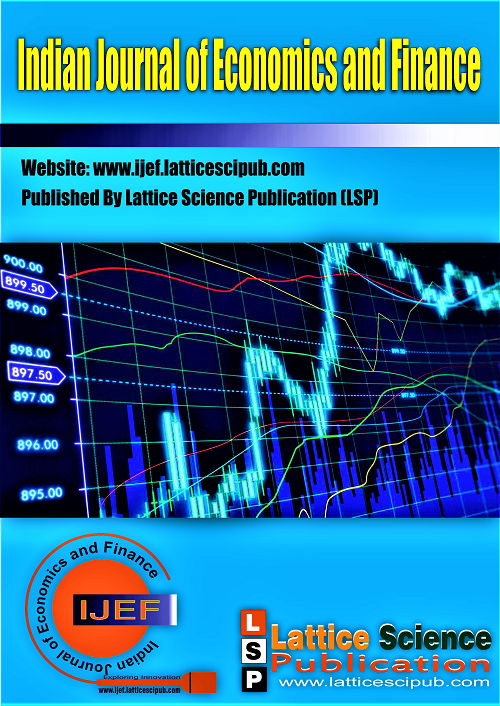Economic Analysis of Income and Employment in the Indian Economy: Granger Causality Approach
Main Article Content
Abstract
This paper investigates the relationship between economic growth and employment in India, focusing on the post-reform period. Using a semi-log quadratic model, the study examines trends in GDP and jobs, drawing comparisons across various countries and income groups. The Granger causality test and the Johansen co-integration technique are employed to analyse the linkages between these variables. The findings reveal that while GDP and employment exhibit positive correlations in some countries, including China, Pakistan, and the USA, the relationship is predominantly negative in India, where corresponding increases in employment have not accompanied GDP growth. Specifically, the study finds that a 1% increase in GDP leads to a 0.28% reduction in employment. The results underscore the “jobless growth” phenomenon in India, where structural shifts towards capital-intensive sectors have led to stagnation in labour absorption. This paper argues that economic growth in India must be redefined to focus on output expansion and inclusive job creation. The paper concludes with policy recommendations aimed at fostering labour-intensive growth, promoting skill development, and addressing regional disparities, to ensure that economic growth translates into equitable employment opportunities for all sectors of society.
Downloads
Article Details

This work is licensed under a Creative Commons Attribution-NonCommercial-NoDerivatives 4.0 International License.
How to Cite
References
Sankaran, U., Abraham, V., & Joseph, K. J. (2010). Impact of Trade Liberalisation on Employment: The Experience of India's Manufacturing Industries. The Indian Journal of Labour Economics, 587-601. Retrieved from https://labordoc.ilo.org/permalink/41ILO_INST/kc2336/alma994627483402676
Ghose, A. K. (2016). India Employment Report: Challenges and the Imperative of Manufacturing- Led Growth. New Delhi: Oxford University Press. Retrieved from https://global.oup.com/academic/product/india-employment-report-2016-9780199472574?cc=id&lang=en&
Papola, T. (2012). Structural Changes in the Indian Economy: Emerging Patterns and Implications. Institute for Studies in Industry Development, 1-29. Retrieved from https://isid.org.in/wp-content/uploads/2022/09/WP144.pdf
Padder, A. H. (2018). Changing Pattern of Economic Development and Employment in India: An Interstate Analysis. Social Science and Humanities International, 1-29. Retrieved from Doi: https://doi.org/10.5281/zenodo.6657218
Padder, A. H., & Mathavan, B. (2021). The Relationship between Unemployment and Economic Growth in India: Granger Causality Approach. NVEO-NATURAL VOLATILES & ESSENTIAL OILS Journal| NVEO, 8(4), 1265-71. Retrieved from https://www.nveo.org/index.php/journal/article/view/261
Aggarwal, A. (2019). Economic Growth, Structural Change and Productive Employment Linkages in India: Did Market Transition Matter? South Asia Economic Journal, 64-85. Doi: https://doi.org/10.1177/1391561418761074
Dopke. (2001). The Employment Intensity of Growth in Europe. Kiel Working Paper. Retrieved from https://www.econstor.eu/bitstream/10419/17746/1/kap1021.pdf
Schmid. (2008). Full Employment in Europe: Managing Labour Market Transitions and Risks. MA: Edward Elgar. Retrieved from https://labordoc.ilo.org/permalink/41ILO_INST/kc2336/alma995042293302676 https://doi.org/10.4337/9781848441477
Granger, C. W. (1969). Investigating Causal Relations by Econometric Models and Cross-spectral Methods. Econometrica, 37(3), 424-38. Retrieved from https://www.jstor.org/stable/1912791
Ayoyinka, S. O., & Isaiah, O. O. (2011). Employment and Economic Growth Nexus in Nigeria. International Journal of Business and Social Science, 232-239. Retrieved from http://ijbssnet.com/journals/Vol._2_No._11_[Special_Issue-June_2011]/33.pdf
Michael, E. O., Emeka, A., & Emmanuel, E. N. (2016). The Relationship between Unemployment and Economic Growth in Nigeria: Granger Causality Approach. Research Journal of Finance and Accounting, 7(24), 153-62. Retrieved from https://iiste.org/Journals/index.php/RJFA/article/view/34823
Habanabakize, T., & Muzindustsi, P. F. (2018). Analysis of the Keynesian Theory of Employment and Sectoral Job Creation: The Case of the South African Manufacturing Sector. Folia Oeconomica Stetinensia, 18(1), 123-143. Doi: https://doi.org/10.2478/foli-2018-0010
Bah, E.-h. M. (2016, May-June). Structural Transformation Path Across Countries. Emerging Markets Finance and Trade, 47(2), 5-19. Doi: https://doi.org/10.2753/REE1540-496X4703S201
Kannan, K. P., & Raveendran, G. (2019). From Jobless to Job-loss Growth, Gainers and Losers During 2012-18. Economic and Political Weekly, 54(44), 38-44. Retrieved from https://www.epw.in/journal/2019/44/insight/jobless-job-loss-growth.html
Roy, S. (2016). Faltering Manufacturing Growth and Employment: Is 'Making' the Answer? Economic and Political Weekly, 51(13), 35-42. Retrieved from https://www.epw.in/journal/2016/13/special-articles/faltering-manufacturing-growth-and-employment.html
Abraham, V. (2017). Stagnant Employment Growth; Last Three Years May Have Been Worst. Economic and Political Weekly, 52(38), 13-17. Retrieved from https://www.epw.in/journal/2017/38/commentary/stagnant-employment-growth.html
Hu, A. (2004). Economic Growth and Employment Growth in China (1978–2001). Asian Economic Papers, 3(2), 166–176. Doi: https://doi.org/10.1162/1535351044193376
Khan, A. Q. K., Khattak, N. U. R. K., & Hussain, A. H. (2008). Inter-Relationship of Gross Domestic Product (GDP) Growth and Unemployment in Pakistan (1960-2005). mpra.ub.uni-muenchen.de/42036/1/MPRA_paper_42036.pdf
Ranamagar, U. B., & Upadhyaya, N. R. (2022). Remittances and Economic Growth: A Causality Analysis for Nepal. In Indian Journal of Economics and Finance (Vol. 2, Issue 2, pp. 25–33). Doi: https://doi.org/10.54105/ijef.b2523.112222
Emmanuel, Dr. R., Sugumar, Dr. S. N., Chandrachud, Dr. S., Jansirani, Dr. S., & Sudha, Dr. S. (2019). The Exorbitant Rise of Educational Expenditure and Its Falling Impact on Economic Growth: An Underlying Cause of Economic Slow-Down. In International Journal of Innovative Technology and Exploring Engineering (Vol. 9, Issue 2, pp. 4855–4859). Doi: https://doi.org/10.35940/ijitee.b8023.129219
Howlader, A., Sankar, S., & Modak, L. A. (2019). Economic Growth and Unemployment Nexus in USA. In International Journal of Recent Technology and Engineering (IJRTE) (Vol. 8, Issue 4, pp. 1317–1325). Doi: https://doi.org/10.35940/ijrte.d7125.118419
Usmanova, A. A., & Usmanov, S. A. (2019). Key Role of Education in the Framework of Achieving the Goals of Sustainable Economic Development. In International Journal of Management and Humanities (Vol. 4, Issue 3, pp. 43–45). Doi: https://doi.org/10.35940/ijmh.a0439.114319





